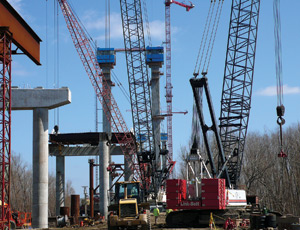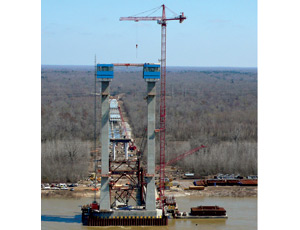By the end of April, a joint venture called Audubon Bridge Constructors plans to begin pulling cable on the John James Audubon Bridge at St. Francisville, La., the longest cable-stayed bridge in North America. The JV has been on the project since April 2006, contending with a vast, wet site and water levels that vary as much as 40 ft. The bridge is expected to be completed in mid-2011.


The 2.44-mile-long bridge has a 1,583-ft main span and two 520-ft-tall H-frame pylons. By the mid-April, ABC was completing the horizontal crossbeams of the H-frames. The towers were at an elevation of 376 ft and on their way to a July completion. ABC started placing deck steel at the end of March.
ABC is a joint venture of Flatiron Constructors Inc., Longmont, Colo., Granite Construction, Watsonville, Calif., and Parsons Transportation Group Inc., Washington, D.C.
The Audubon bridge is the centerpiece of a $408.5-million design-build project that also includes 12 miles of roadway approaches and seven conventional bridges linking Louisiana Highways 1 and 10 to the west and Highway 61 to the east.
The bridge and its approaches are the Louisiana Dept. of Transportation and Development’s first design-build project. It also is the only drill-shaft-supported bridge in the lower reaches of the Mississippi River.
The cable system to be installed is being introduced to the U.S. for the first time, says Frank Daams, ABC’s project manager. It is manufactured by VSL International AG, Switzerland, using galvanized steel strands made in Spain.
Each 0.68-in.-dia strand is encased in polyethylene. Twenty strands will be used for the shortest of the bridge’s 136 cables. The longest cable, at 830 ft, will be made of 69 strands. Each cable will be bound in a high-density polyethylene pipe, lined with a carbon layer. The cable will anchor on the tower and the deck inside the cable boxes cast into the concrete. After the cable is post-tensioned, a removable steel cap will be placed on either end of the cable to serve as a form for the sealing epoxy. “Once gelled, the epoxy has the consistency of a Superball,” says Sereno Brown, ABC project engineer. “Remember those?”
Strands will be installed from the deck, with the first one actually supporting the HDPE sheathing, including the connection and expansion sections at each end and a galvanized, anti-vandalism shield at the base. “The remaining strands will be winched up to the tower from the deck through the HDPE sleeve and will be stressed one by one until all the strands have been stressed,” Brown says. VSL is providing most of the equipment, including stay-cable jacks, pumps, computers, winches, de-spoolers, cutting tables and on-deck access platforms.
Water Challenges
Managers say they have devised techniques to let cabling and other critical-path work go forward even if spring floods try to interfere, Daams says. “The river is always a challenge. It shut down the job for about six months in 2008 when we were still doing foundation work.”
Brown says the team is monitoring the spring melt upriver in Minnesota “with fingers crossed.”
During times of high water, access from shore is via a steel pipe-pile and I-beam girder trestle at a 54-ft elevation, which ABC constructed shortly after breaking ground. The rest of the central work area has been above water since October, when ABC completed the concrete footings for the pylons.
Each footing is supported by 21 8-ft-dia. concrete-and-rebar-filled steel shafts that were drilled to -175 ft on the west bank and -180 ft on the east bank, Brown says. The shafts were capped with 160 x 64-ft, 3,000-cu-yd, +20-ft footings and +50-ft pedestal toppings built with another 300 to 400 cu yds of concrete.
“It’s hard to say the exact height of the supports because it depends on water level, which varies from +12 to +52 ft,” Daams says. The sturdy design is to resist hurricanes, scouring and barge impact.
To combat the ever-changing water levels while building the foundations, Flatiron designed a proprietary...

Post a comment to this article
Report Abusive Comment